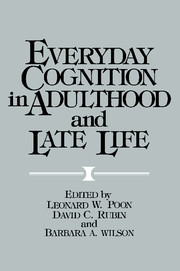Book contents
- Frontmatter
- Contents
- List of contributors
- Preface
- Part I Adult cognitive abilities in the laboratory and in real-life settings: Basic theoretical and methodological issues
- Part IA Systematic approaches to laboratory and real-world research
- Part IB Combining laboratory and real-world research
- Part II Cognition in adulthood and late life: Findings in real-life settings
- Part IIA Everyday cognitive abilities
- Part IIB Concomitant influences
- Part III Cognitive enhancement and aging: Clinical and educational applications
- Part IIIA Issues and perspectives
- Part IIIB Enhancement approaches
- Part IIIC Designing programs for cognitive rehabilitation
- 32 Designing memory-therapy programs
- 33 Management of memory problems in a hospital setting
- 34 Home-based cognitive rehabilitation with the elderly
- 35 Memory retraining: Everyday needs and future prospects
- Subject index
- Author index
34 - Home-based cognitive rehabilitation with the elderly
Published online by Cambridge University Press: 05 October 2013
- Frontmatter
- Contents
- List of contributors
- Preface
- Part I Adult cognitive abilities in the laboratory and in real-life settings: Basic theoretical and methodological issues
- Part IA Systematic approaches to laboratory and real-world research
- Part IB Combining laboratory and real-world research
- Part II Cognition in adulthood and late life: Findings in real-life settings
- Part IIA Everyday cognitive abilities
- Part IIB Concomitant influences
- Part III Cognitive enhancement and aging: Clinical and educational applications
- Part IIIA Issues and perspectives
- Part IIIB Enhancement approaches
- Part IIIC Designing programs for cognitive rehabilitation
- 32 Designing memory-therapy programs
- 33 Management of memory problems in a hospital setting
- 34 Home-based cognitive rehabilitation with the elderly
- 35 Memory retraining: Everyday needs and future prospects
- Subject index
- Author index
Summary
Strain on those caring for the elderly
Although there has been an emphasis on the development of day-hospital and community provisions, there is little evidence that such facilities provide an alternative to hospital care or relieve the strain on the carers, which is the main reason for referral (Greene & Timbury, 1979). It is well recognized that there is severe strain on carers, and there are deleterious effects on their health. Gilleard (1984) reported that on the General Health Questionnaire (GHQ) (Goldberg, 1978), 73% of persons caring for patients attending a geriatric or psychogeriatric day hospital probably were suffering from some degree of psychiatric disturbance. The reported level of distress among those caring for psychogeriatric patients was only just higher than the level for those caring for geriatric patients (Table 34.1).
Gilleard also noted that there was no significant difference between the two groups of carers in regard to the numbers of problems reported. However, the nature of the problems did distinguish between the two groups. In general, the geriatric patients experienced greater impairments of mobility, which have been shown to be reasonably well tolerated by carers (Isaacs, 1971). This group of carers also described significant levels of behavioral disturbance and/or communications problems, although these were less frequent than those reported by people caring for psychogeriatric patients. These behavioral and communications problems are particular sources of strain for carers.
- Type
- Chapter
- Information
- Everyday Cognition in Adulthood and Late Life , pp. 659 - 680Publisher: Cambridge University PressPrint publication year: 1989
- 18
- Cited by



